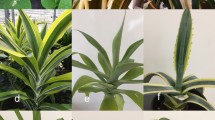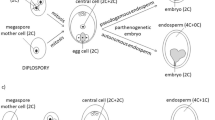Abstract
In this review, the different applications of flow cytometry in plant breeding are highlighted. Four main breeding related purposes can be distinguished for flow cytometry: (i) Characterisation of available plant material, including screening of possible parent plants for breeding programs as well as evaluation of population biodiversity; (ii) Offspring screening after interspecific, interploidy or aberrant crosses; (iii) Ploidy level determination after haploidization and polyploidization treatments and (iv) Particle sorting, that allows separation of plant cells based on morphological or fluorescent characteristics. An overview and discussion of these various applications indicates that flow cytometry is a relatively quick, cheap and reliable tool for many breeding related objectives.
Similar content being viewed by others
Abbreviations
- DAPI:
-
4′, 6-diamidino-2-phenylindol
- EB:
-
ethidium bromide
- FCM:
-
flow cytometry
- FDA:
-
fluorescein diacetate
- FSC:
-
forward scatter
- ORY:
-
oryzalin
- PI:
-
propidium iodide
- PMT:
-
photomultiplier
- SSC:
-
sideward scatter
- TRI:
-
trifluralin
References
Arumuganathan K., Earle E. 1991. Estimation of nuclear DNA content of plants by flow cytometry. Plant Mol. Biol. Rep. 9: 229–233.
Bennett M., Leitch I. 1995. Nuclear DNA amount in angiosperms. Ann. Bot. 76: 113–176.
Bennett M., Bhandol P., Leitch I. 2000. Nuclear DNA amounts in angiosperms and their modern uses: 807 new estimates. Ann. Bot. 86: 859–909.
Crespel L., Gudin S., Meynet J., Zhang D. 2002. AFLP-based estimation of 2n gametophytic heterozygosity in two parthenogenetically derived dihaploids of Rosa hybrida L. Theor. Appl. Genet. 104: 451–456.
Crissman H., Steinkamp J. 1973. Rapid simultaneous measurement of DNA, protein and cell volume in single cells from large mammalian cell populations. J. Cell Biol. 59: 766–771.
De Laat A., Göhde W., Vogelzang M. 1987. Determination of ploidy of single plants and plant populations by flow cytometry. Plant Breeding 99: 303–307.
De Schepper S., Leus L., Eeckhaut T., Van Bockstaele E., Debergh P., De Loose M. 2004. Somatic polyploid petals: regeneration offers new roads for breeding Belgian pot azaleas. Plant Cell Tiss. Org. Cult. 76: 183–188.
De Schepper S., Leus L., Mertens M., Van Bockstaele E., Debergh P., De Loose M. 2001. Flow cytometric analysis of ploidy in Rhododendron (subgenus Tsutsusi). HortScience, 36: 125–127.
Dolezel J. 1991. Flow cytometric analysis of nuclear DNA content in higher plants. Phytochem. Anal. 2: 143–154.
Dolezel, J. 1997. Applications of flow cytometry for the study of plant genomes. J. Appl. Genet. 38:285–302.
Dolezel J., Bartos J. 2005. Plant DNA flow Cytometry and estimation of nuclear genome size. Ann. Bot. 95: 99–110.
Dolezel J., Binarova P., Lucretti S. 1989. Analysis of nuclear DNA content in plant cells by flow cytometry. Biol. Plant. 31: 113–120.
Dolezel J., Göhde W. 1995. Sex determination in dioecious plants Melandrium album and M. rubrum using high-resolution flow cytometry. Cytometry 19: 103–106.
Dolezel J., Sgorbati S., Lucretti S. 1992. Comparison of three DNA fluorochromes for flow cytometric estimation of nuclear DNA content in plants. Physiol. Plant. 85: 625–631.
Eeckhaut T., Samijn G., Van Bockstaele E. 2003. Interspecific breeding in the Rhododendron genus involving R. simsii hybrids. Acta Horticult. 612: 165–172.
Eeckhaut T., Van Huylenbroeck J., De Riek J., Van Bockstaele E. 2004. Interspecific hybridization between Hibiscus syriacus L and Hibiscus paramutabilis Bailey. Acta Horticult. 630: 85–90.
Galbraith D. 1989. Analysis of higher plants by flow cytometry and cell sorting. Int. Rev. Cytol. 116: 165–228.
Galbraith D. 1990. Flow cytometric analysis of plant genomes. Methods Cell Biol. 33: 549–561.
Galbraith D., Harkins K., Maddox J., Ayres N., Sharma D., Firoozabady E. 1983. Rapid flow cytometrical analysis of the cell cycle in intact plant tissues. Science 220: 1049–1051.
Goldblatt P. 1980. Polyploidy in angiosperms. In: Polyploidy, ed. by Bu W. Lewis. Plenum Press, New York: 219–239.
Herzenberg L., Parks D., Sahaf B., Perez O., Roederer M., Herzenberg L. 2002. The history and future of the fluorescence activated cell sorter and flow cytometry: a view from Stanford. Clinical Chem. 48: 1819–1827.
Horner H., Hall V., Vargas-Olvera M. 1993. Isolation, sorting, and characterization of uni- and binucleate tapetal protoplasts from anthers of normal and Texas cytoplasmic male-sterile Zea mays L. Protoplasma 173: 48–57.
Janaki Ammal E., Enoch I., Bridgewater M. 1950. Chromosome numbers in species of Rhododendron. The Rhododendron Yearbook. Royal Horticult. Soc. 5: 78–91.
Kachel V., Messeschmidt R., Hummel P. 1990. Eight-Parameter PC-AT Based Flow Cytometric Data System. Cytometry 11: 805–812.
Li L., Arumuganathan K. 2003. Microcloning of maize chromosome 9 by using a flow-sorting technique. Plant Mol. Biol. Rep. 21: 359–364.
Laurie D., Bennett M. 1985. Nuclear DNA content in the genera Zea and Sorghum: intergeneric, interspecific, and intraspecific variation. Heredity 55: 307–313.
Masterson J. 1994. Stomatal size in fossil plants: evidence for polyploidy in majority of angiosperms. Science 264: 421–424.
Moyne A., Souq F., Yean L., Brown S., Boulay M., Sangwan-Norreel B. 1993. Relationship between cell ploidy and regeneration capacity of long term Rosa hybrida cultures. Plant Sci. 93: 159–168.
Ochatt S., Mousset-Déclas C., Rancillac M. 2000. Fertile pea plants regenerate from protoplasts when calluses have not undergone endoreduplication. Plant Sci. 156: 177–183.
Osborn T., Pires J., Birchler J., Auger D., Chen Z., Lee H., Comai L., Madlung A., Doerge R., Colot V., Martienssen R. 2003. Understanding mechanisms of novel gene expression in polyploids. Trends in Genetics 19: 141–147.
Portugal J., Waring M. 1988. Assignment of DNA binding sites for 4′,6-diamidino-2-phenylindole and bisbenzimide (Hoechst 33258). A comparative footprinting study. Biochim. Biophys. Acta 949: 158–168.
Shapiro H. 2003. Practical flow Cytometry, 4th edn. Wiley Liss, New York, 736 pp.
Soltis D., Soltis P. 1993. Molecular data and the dynamic nature of polyploidy. Critical Rev. Plant Sci. 12: 243–273.
Stebbins G. 1971. Chromosomal evolution of higher plants. Edward Arnold Ltd, London, 216 pp.
Tusa N., Loredana A., Ferrante S., Lucretti S., Scarano M. 2002. Identification of zygotic and nucellar seedlings in Citrus interploid crosses by means of isozymes, flow cytometry and ISSR-PCR. Cell. Mol. Biol. Letters 7: 703–708.
Van Dyke M., Dervan P. 1983. Chromomycin, mithramycin, and olivomycin binding sites on heterogenous deoxyribonucleic acid. Footprinting with (methidiumpropyl-EDTA) iron (II). Biochemistry 22: 2373–2377.
Van Huylenbroeck J., Leus L., Van Bockstaele E. 2005. Interploidy crosses in roses: use of triploids. Acta Horticulturae 690: 109–112.
Wendel J. 2000. Genome evolution in polyploids. Plant Mol. Biol. 42: 225–249.
Yokoya K., Roberts A., Mottley J., Lewis R., Brandham P. 2000. Nuclear DNA amounts in roses. Ann. Bot. 85: 557–561.
Zlesak D., Thill C., Anderson N. 2005. Trifluralin-medated polyploidization of Rosa chinensis minima (Sims) Voss seedlings. Euphytica 141: 281–290.
Author information
Authors and Affiliations
Rights and permissions
About this article
Cite this article
Eeckhaut, T., Leus, L. & Van Huylenbroeck, J. Exploitation of flow cytometry for plant breeding. Acta Physiol Plant 27, 743–750 (2005). https://doi.org/10.1007/s11738-005-0079-2
Accepted:
Issue Date:
DOI: https://doi.org/10.1007/s11738-005-0079-2




